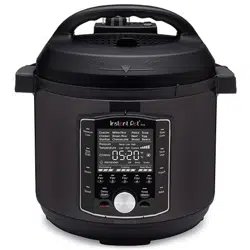Documents: Go to download!
- Owner's manual - (English)
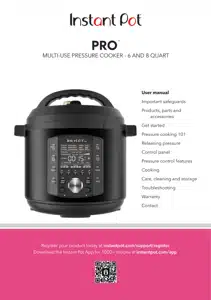
- Get started
- Pressure cooking 101
- Control panel
- Settings
- Cooking
- Using Favorite Programs
- Care, cleaning and storage
- Troubleshooting
Table of contents
User Manual Pressure Cooker
Get started
Initial set up (It won't bite!)
“The only real stumbling block is fear of failure. In cooking you’ve got to have a what-the-hell attitude.” – Julia Child
- Pull that Instant Pot Pro out of the box!
- Remove the packaging material and accessories from in and around the multicooker and make sure all the parts are accounted for. See Product, parts and accessories for a full parts breakdown.
- Make sure to check under the inner pot
- Wash the inner pot in a dishwasher or with hot water and dish soap. Rinse it well with warm, clear water and use a soft, dry cloth to thoroughly dry the outside of the inner pot
- Wipe the heating element with a soft, dry cloth to make sure there are no stray packaging particles left in the multicooker base.
- Don’t remove the safety warning stickers from the lid (unless specified on the sticker!) or the labels from the back of the multicooker base.
- You may be tempted to put the Pro on your stovetop — but don’t do it! Place the multicooker base on a stable, level surface, away from combustible material and external heat sources
Is something missing or damaged?
Get in touch with a Customer Care Advisor through our chat widget at instantpot.com/#chat, by email at [email protected] or by phone at 1-800-828-7280 and we’ll happily make some magic happen for you!
Feeling keen?
While you’re doing the Initial test run (water test), read over Pressure cooking 101 to find out how the magic happens, and read through Pressure control features for an in-depth look.
WARNING
- Read the Important safeguards before using the appliance. Failure to read and follow those instructions for safe use may result in damage to the appliance, personal injury and/or property damage.
- Do not place the appliance on a stovetop or upon another appliance. Heat from an external source will damage the appliance.
- Do not place anything on top of the appliance, and do not cover or block the steam release valve or anti-block shield, located on the appliance lid to avoid risk of injury and/or property damage.
- Do not place the appliance on a stovetop or upon another appliance. Heat from an external source will damage the appliance.
Do not place anything on top of the appliance, and do not cover or block the steam release valve or anti-block shield, located on the appliance lid to avoid risk of injury and/or property damage.
Initial test run (water test)
Do you have to do the water test? No — but getting to know the ins and outs of your new Pro prepares you for success in the kitchen! Take a few minutes to get to know how this tireless kitchen hero works
Stage 1: Setting up the Pro for pressure cooking
- Remove the inner pot from the multicooker base and fill it to the first line (1) with water.
- Insert the inner pot into the multicooker base.
- Connect the power cord to a 120 V power source. The display shows OFF.
- Place and close the lid as described in Pressure control features: pressure cooking lid.
- The lid automatically seals for pressure cooking.
Stage 2: "Cooking" (...but not really, this is just a test!)
- Touch Pressure Cook.
- When Custom flashes, press the dial to select it and go to the next field.
- When the pressure level flashes, press the dial to select High pressure and go to the next field.
- When the time flashes, turn the dial to adjust the cook time to 5 minutes (00:05). Press the dial to confirm the change and go to the next field.
- Customizations are saved to the Smart Program when cooking begins
- When Reminder flashes, turn the dial to toggle between vent reminder options. Select Off and press the dial to confirm. See Control panel for more information
- Select Off and press the dial to confirm.
- Touch Start to begin.
- The display shows On and the cooking progress bar shows Pre-heating.
- Keep Warm turns on automatically after some Smart Programs finish. Touch Keep Warm to turn the setting off for this test.
Instant tip: While the multicooker does its thing, read Pressure cooking 101 to find out how the magic happens.
Stage 3: Releasing pressure
- When Cooking finishes, the display shows End.
- If you have set a 5 or 10 minute vent reminder, the reminder timer begins to count down.
- Follow instructions for a Quick Release in Releasing pressure: Venting methods.
- Wait for the float valve to drop, then carefully open and remove the lid as described in Pressure control features: Pressure cooking lid.
- Using proper hand protection, remove the inner pot from the multicooker base, discard the water and thoroughly dry the inner pot.
That's it! You're good to go :)
DANGER
- DO NOT attempt to remove the lid while the float valve is up and NEVER attempt to force the lid open. Contents are under extreme pressure. Float valve must be down before attempting to remove the lid. Failure to follow these instructions may result in serious personal injury and/or property damage.
CAUTION
- Pressurized steam releases through the top of the steam release valve. Keep exposed skin away from the steam release valve to avoid burn injury.
- The inner pot will be hot after cooking. Always use appropriate heat protection when handling a hot inner pot to avoid burn injury.
Pressure cooking 101
Pressure cooking uses steam to raise the boiling point of water above 100ºC / 212ºF. These high temperatures allow you to cook some foods way faster than normal.
Behind the magic curtain
When pressure cooking, the Instant Pot goes through 3 stages
- Pre-heating
- The cooking progress bar shows Pre-heating. The display shows On.
- While the multicooker pre-heats, it vaporizes liquid to create steam.
- Once enough steam has built up, the float valve pops up and locks the lid in place.
- The time it takes the multicooker to pressurize depends on things like food and liquid temperature and volume
- Frozen foods have the longest preheating time. For the fastest results, thaw your food before cooking it
- No need to hang around during this stage — trust that IP magic!
- The cooking progress bar shows Pre-heating. The display shows On.
- Cooking
- The cooking progress bar moves over to Cooking
- The display switches to the cooking countdown timer.
- When the Instant Pot reaches the required pressure level, cooking begins.
- The multicooker automatically maintains High or Low pressure throughout cooking.
- A higher pressure means a higher temperature.
- Smart Program settings (e.g., cooking time, pressure level, etc.) can be adjusted at any time during cooking
- Depressurization
- If Keep Warm is on after cooking, the cooking progress bar moves over to Keep Warm, and the timer counts up from 00:00. If not, the multicooker returns to standby and displays End.
- Although food has finished cooking, the pressure cooker is still pressurized and hot.
- Venting the pressure lowers the temperature and allows you to safely remove the lid.
- Follow your recipe instructions when choosing a venting method
- See Releasing pressure: Venting methods on the next page for information on safe venting techniques.
- Instant Tip: The Instant Pot cools faster if Keep Warm is turned off!
- If Keep Warm is on after cooking, the cooking progress bar moves over to Keep Warm, and the timer counts up from 00:00. If not, the multicooker returns to standby and displays End.
Releasing pressure
You must release pressure after pressure cooking before attempting to open the lid.
Follow your recipe’s instructions to choose a venting method, and always wait until the float valve drops into the lid before opening.
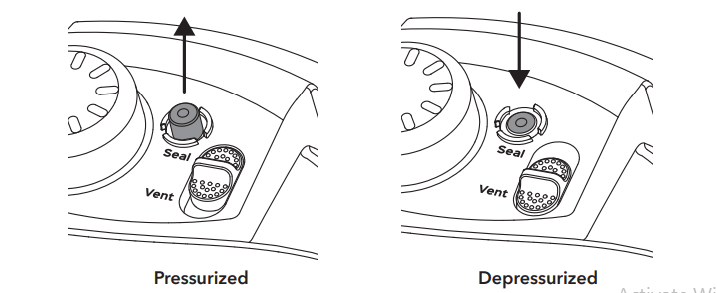
WARNING
- Steam ejected from the steam release valve is hot. DO NOT place hands, face, or any exposed skin over the steam release assembly when releasing pressure to avoid injury.
- Do not cover or obstruct the steam release valve or cover to avoid injury and/or property damage
DANGER
- DO NOT attempt to remove the lid while the float valve is up and NEVER attempt to force the lid open. Contents are under extreme pressure. Float valve must be down before attempting to remove the lid. Failure to follow these instructions may result in serious personal injury and/or property damage.
Venting methods
- Natural Release (NR or NPR)
- Quick Release (QR or QPR)
- Timed Natural Release
Natural Release (NR or NPR)
Cooking stops gradually. As the temperature within the multicooker drops, the Instant Pot Pro depressurizes naturally over time.
- After cooking finishes, leave the quick release switch in the Seal position until the float valve drops into the lid.
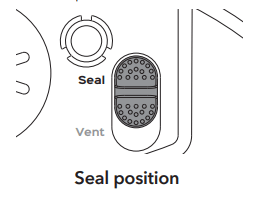
- Your meal continues to cook even after the Smart Program ends.
- Instant Tip: This is called “carryover cooking” or “resting”, and it’s great for large cuts of meat.
- The depressurization time may vary based upon the volume, type and temperature of food and liquid. Unless you use QuickCool™ technology, NR can take up to 40 minutes with some dishes, so plan ahead — it’s well worth the wait!
- See QuickCool to find out how to naturally release pressure faster than ever before!
- Your meal continues to cook even after the Smart Program ends.
NOTICE
- Use NR to depressurize the multicooker after cooking high-starch foods (like soups, stews, chilis, pasta, oatmeal and congee) or after cooking foods that expand when cooked (like beans and grains).
Quick Release (QR or QPR)
Stops cooking quickly and prevents overcooking. Perfect for quick-cooking vegetables and delicate seafood!
- Move the quick release switch from Seal to Vent and wait until the float valve drops into the lid.
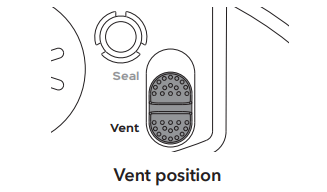
- When the steam release cover is installed properly, you’ll hear a muffled hiss as steam hits the cover and disperses
- If the cover is not installed properly, a loud jet of steam will eject through the top of the steam release valve
NOTICE
- Do not use QR when cooking fatty, oily, thick or high-starch foods (e.g., stews, chilis, pasta and congee) or when cooking foods that expand when cooked (e.g., beans and grains).
Timed Natural Release
The carryover cooking continues for a specific amount of time, then stops quickly when you release the remaining pressure. Perfect for cooking rice and grains.
- Leave the quick release switch in the Seal position for a few minutes (according to your recipe) then move it from Seal to Vent and wait until the float valve drops into the lid.
- When the steam release cover is installed properly, you’ll hear a muffled hiss as steam hits the cover and disperses.
- If the cover is not installed properly, a loud jet of steam will eject through the top of the steam release valve.
- The temperature within the multicooker drops, so the steam release may not be as powerful as a normal QR.
If you see a lot of spatter while releasing pressure, move the quick release switch back from Vent to Seal, and wait a few minutes before trying to release pressure again. If spatter continues, use NR to safely release the remaining pressure.
Vent reminder
Set a reminder for your Timed Natural Release so you can step away and own your day.
- Quick Release
- Off
- 5 minute Timed Natural Release
- 5 min
- 10 minute Timed Natural Release
- 10 min
CAUTION
- Steam ejected from the steam release valve is hot. DO NOT place hands, face, or any exposed skin over the steam release assembly when releasing pressure to avoid injury.
Control panel
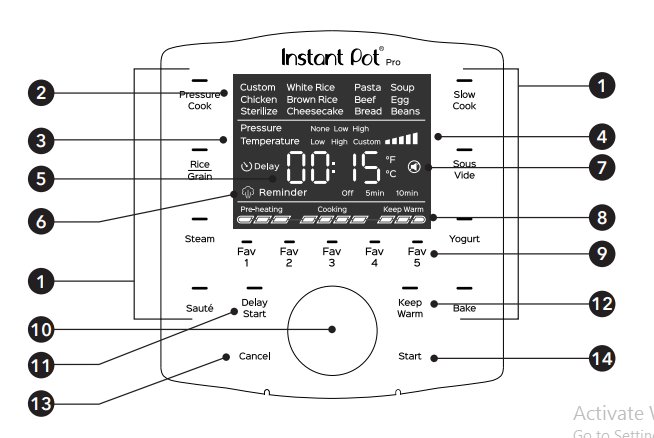
- Smart Programs
- Pressure Cook
- Rice/Grain
- Steam
- Sauté
- Slow Cook
- Sous Vide
- Yogurt
- Bake
- See Cooking for details.
- Preset cooking options
- After selecting a Smart Program, choose from a variety of popular presets.
- All preset cooking options are customizable
- After selecting a Smart Program, choose from a variety of popular presets.
- Pressure
- Choose between None, Low and High
- Temperature
- Choose between Low, High, and Custom
- Time display
- In standby, shows OFF.
- For Smart Programs the display counts down and for Keep Warm, the display counts up.
- Some Smart Programs display the temperature in ºC (Celsius) or ºF (Fahrenheit).
- Vent reminder
- Only used when pressure cooking.
- Sounds
 Sounds are on
Sounds are on Sounds are off.
Sounds are off. Audible safety and error message alerts cannot be turned off. See Control panel: Settings for more information.
Audible safety and error message alerts cannot be turned off. See Control panel: Settings for more information.
- Cooking progress bar
- Shows when the multicooker is in Pre-heating, Cooking and Keep Warm.
- See Control panel: Cooking progress bar for more information
- Fav 1 to 5
- One-touch access to 5 of your favorite recipes.
- See Cooking: Fav 5 for more information
- Control dial
- Turn the dial to scroll through Smart Programs, modify status icons, and adjust the time, temperature, and pressure levels.
- The dial is also a button. Press the dial to confirm your selections
- Turn the dial to scroll through Smart Programs, modify status icons, and adjust the time, temperature, and pressure levels.
- Delay Start
- Delay the start of cooking. Doubles as a kitchen timer!
 Icon appears when Delay Start timer is counting down
Icon appears when Delay Start timer is counting down
- Keep Warm
- Turns Keep Warm on or off
- Can only be used with Pressure Cook, Rice and Slow Cook, or as a standalone program when in standby.
- Turns Keep Warm on or off
- Cancel
- Stops a Smart Program at any time and returns the multicooker to standby.
- Start
- Begins the selected Smart Program.
Cooking progress bar

- Preheating
- Pre-heating is in progress. The display shows On during the preheating stage to let you know that it’s working on getting up to temperature.
- Cooking
- Cooking starts after the Pro reaches the target pressure or temperature required by the Smart Program. The display counts down the remaining cooking time
- Keep Warm
- Keep Warm comes on automatically after cooking finishes to keep your meal at serving temperatures. The timer counts up the elapsed time to a maximum of 10 hours (10:00). When Keep Warm completes, the display shows End.
Status messages
 |
The Pro is in standby mode, ready to make your next favorite meal. |
 |
The multicooker is Pre-heating. |
 |
The inner pot has reached the perfect cooking temperature and food can be added.
|
 |
The display shows one of the following:
|
 |
The Yogurt Smart Program is set to pasteurization mode. See Cooking: Yogurt for more information. |
 |
Displays when you’re setting up Sous Vide cooking to show the default temperature setting. To set a custom cooking temperature, turn the dial when the temperature flashes. Then press the dial to make your selection |
 |
Displays when you press a Fav key to save a Favorite recipe. |
 |
Displays when you press a Fav key that hasn’t been saved as a Favorite. Number will change between 1-5 depending on the missing Fav setting selected. |
 |
When cooking finishes, the display shows End until you remove the lid or touch Cancel. |
Do you see something else? See Troubleshooting for more information.
Settings
- Change displayed temperature (°C and °F)
- In standby, press and hold the dial for 5 seconds. When the temperature unit flashes, turn the dial to toggle between °C and °F, then press Start to save the change.
- Turn sound on or off.
- In standby, press and hold the dial for 5 seconds.
- When the temperature unit flashes, press the dial to go to the sound field.
- When the sound icon flashes, turn the dial to toggle the sound on and off, then press Start to save the change.
- Audible safety and error message alerts cannot be turned off.
- Adjust and save custom cooking times and temperatures.
- Changes to the cooking time, temperature and pressure level are saved once the Smart Program begins
- See Cooking for more information.
- On-the-fly changes to cooking settings.
- Once a Smart Program has started, press the dial to enter the cooking settings.
- Turn the dial to adjust settings, then press the dial to confirm your changes and go to the next field.
- When you’re happy with the settings, touch Start to confirm your changes and resume cooking.
- Changes made during cooking are not saved to memory.
-
Delay the start of cooking.
- Default time
- 6 hours (06:00)
- Time range
- 10 minutes to 24 hours (00:10 to 24:00)
- Select and set up an applicable Smart Program.
- After programming the Smart Program, touch Delay Start.
- When the time flashes, turn the dial to adjust the delay time as needed.
- Touch Start to begin the delay countdown
- Delay Start cannot be used with Sauté, Yogurt, Sous Vide or Steam
- Default time
- Reset an individual Smart Program.
- When in standby, touch and hold the Smart Program button you want to reset for 5 seconds.
- The Smart Program’s cooking time, pressure level and/or temperature are restored to the factory default setting.
- The Fav 5 programs cannot be reset individually
- Reset all Smart Programs.
- When in standby, touch and hold Cancel until the multicooker beeps
- All Smart Program cooking times, pressure levels and/or temperatures are restored to factory default settings
Pressure control features (Your little bag of tricks!)
See Care, cleaning and storage for installation and removal of parts
Pressure cooking lid
| What we love about it | What you should know about it |
|
|
Removing the lid
- Grip the lid handle and turn it counterclockwise to align the symbol on the lid
 with the symbol on the rim of the multicooker base
with the symbol on the rim of the multicooker base 
- Lift the lid up and off the multicooker base towards your body.
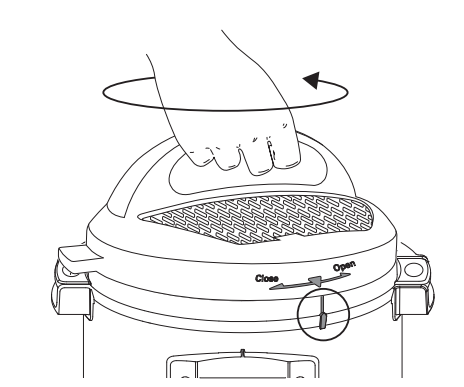
See Releasing pressure: Venting methods for safe depressurization techniques
Closing the lid
- Align the symbol on the lid
 with the symbol on the multicooker base
with the symbol on the multicooker base  , then lower the lid onto the track.
, then lower the lid onto the track. - Turn the lid
 clockwise until the symbol on the lid aligns with the middle of the control panel.
clockwise until the symbol on the lid aligns with the middle of the control panel.
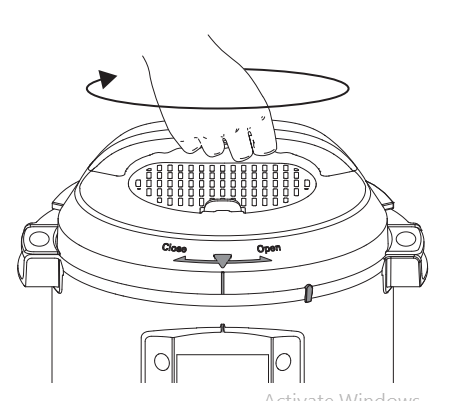
Pressure control features
QuickCool™
For the fastest Natural Release after pressure cooking, use the QuickCool tray*.
| What we love about it | What you should know about it |
| It’s a huge timer saver — you can release pressure naturally up to 50% faster! | The metal portion of the lid gets extremely hot, so don’t remove the protective cover unless you’re using QuickCool. |
To use the QuickCool tray, fill it with ice or water and freeze it. Once frozen, remove the protective cover from the pressure cooking lid, and position the QuickCool tray on the exposed metal of the lid.
When the float valve drops into the lid, remove the QuickCool tray, discard the water and open the lid. Use caution when removing the tray as some or all of the ice may have melted.
*QuickCool tray sold separately at instantbrands.com/product/instant-pot/accessories.
CAUTION: The lid will be hot during and after cooking. Do not touch the exposed metal with bare skin to avoid injury.
Quick release switch
The quick release switch controls the steam release valve — the part that releases pressure.
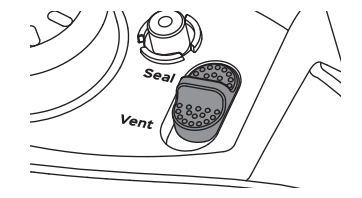
| What we love about it | What you should know about it |
| It’s super easy to use, and keeps our hands far away from the steam when the multicooker is releasing pressure! | It automatically sets to Seal when you close the lid, so make sure to move it to Vent when you’re not pressure cooking. |
Pressure control features

See Releasing pressure: Venting methods for safe depressurization techniques
Steam release assembly
The steam release assembly must be fully installed before use.
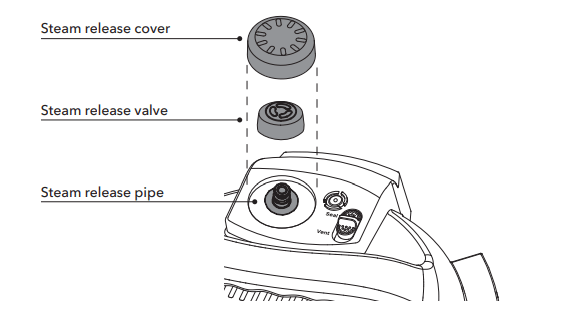
| What we love about it | What you should know about it |
| When the valve is venting, the steam release cover disperses the steam, so the quick release of pressure is soft and gentle. |
When releasing pressure, steam travels up from the inner pot, through the steam release pipe and out from the top of the steam release valve — so it’s important to keep the area clean and clear. The steam release valve sits loosely on the steam release pipe. |
WARNING: Do not cover or block the steam release assembly in any way to avoid injury and/or property damage.
Pressure control features
Anti-block shield
- The anti-block shield prevents food particles from coming up through the steam release pipe, which assists with pressure regulation.
- The anti-block shield is integral to product safety and necessary for pressure cooking, so it must be installed before use.
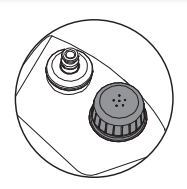
Sealing ring
- When the pressure cooking lid is closed, the sealing ring creates an air-tight seal between the lid and the inner pot.
- The sealing ring must be installed before use.
- Only one sealing ring should be installed in the lid at a time.
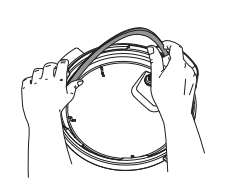
Instant Tip: Silicone is porous, so it absorbs strong aromas and certain flavors. Keep extra sealing rings on hand to limit the transfer of those aromas and flavors between dishes. Visit our store to start color coding your cooking!
CAUTION:
- Always check for cuts, deformation and correct installation before cooking, as sealing rings stretch over time with normal use. If you notice stretching, deformation, or damage to your sealing ring, DO NOT use it.
- Replace the sealing ring every 12 to 18 months or sooner, and only use authorized Instant Pot sealing rings.
- Failure to follow these instructions may cause food to discharge, which may lead to personal injury or property damage.
Pressure control features
Float valve
The float valve lets you know when there is pressure in the multicooker (pressurized) or not (depressurized). It appears in 2 positions:
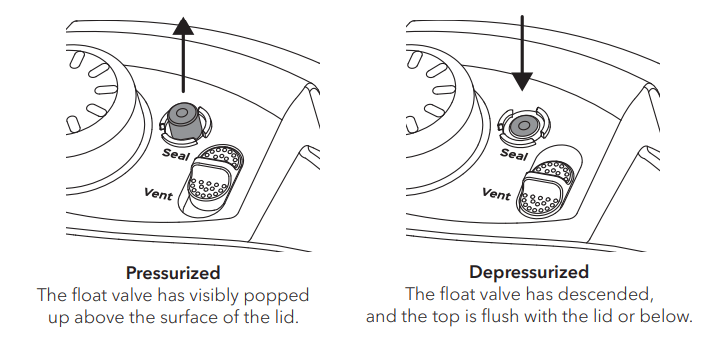
The float valve and silicone cap work together to seal in pressurized steam. These parts must be installed before use. Do not attempt to operate the Instant Pot without the float valve properly installed. Do not touch the float valve during use.
DANGER: DO NOT attempt to remove the lid while the float valve is up and NEVER attempt to force the lid open. Contents are under extreme pressure. Float valve must be down before attempting to remove the lid. Failure to follow these instructions may result in serious personal injury and/or property damage.
Cooking
The Instant Pot Pro is amazingly versatile in the kitchen. No matter what kind of cooking you want to do, the Pro has you covered.
CAUTION:
Always inspect the lid and inner pot carefully to make sure they are clean and in good working condition before use.
- To avoid personal injury or damage to the appliance, replace the inner pot if it is dented, deformed or damaged.
- Use only authorized Instant Pot inner pots made for this model when cooking.
Always make sure the heating element is clean and dry before inserting the inner pot into the multicooker base.
Failure to follow these instructions may damage the multicooker. Replace damaged parts to make sure safe function.
WARNING:
- DO NOT fill inner pot higher than the Max PC Fill line as indicated on the inner pot to avoid personal injury and/or property damage.
- When cooking foods that expand (e.g., rice, beans, pasta) do not fill the inner pot higher than the Half Fill line as indicated on the inner pot.
- Always cook with the inner pot in place. DO NOT pour food or liquid into the multicooker base. To avoid risk of personal injury and/or property damage, place food and liquid ingredients in the inner pot, then insert the inner pot into the multicooker base.
CAUTION:
When cooking meat, always use a meat thermometer to ensure the internal temperature reaches a safe minimum temperature. Refer to the USDA’s Safe Minimum Internal Temperature Chart.
Smart program overview
| Smart Program | Cooking presets | Pressure levels | Tips |
| Pressure Cook | Custom, Chicken, Sterilize, Pasta, Beef, Soup, Egg, Beans | Low High | It is recommended to use timed Natural Release or follow recipes for the best outcome. |
| Rice/Grain | Custom, White Rice, Brown Rice | Low High | |
| Steam | Custom | This is a non-pressure steam program which is great for cooking delicate food, like zucchini and broccoli. | |
| Sauté | Custom | Level 1 to 5 works like your stovetop sauté pan where 5 is the highest heat for browning, and 1 is the lowest heat for simmer. | |
| Slow Cook | Custom, Chicken, Beef, Beans, Soup |
Works just like a traditional slow cooker. Ensure cooking time is set to 4 hours or more for optimal result. Caution: Cooking less than 3 hours will result in uncooked food |
|
| Sous Vide | Custom, Chicken, Beef, Egg | ||
| Yogurt | Custom | ||
| Bake | Custom, Cheesecake, Bread | None Low High | |
| Keep Warm | Custom, Low High. |
Pressure Cook and Rice
Jump start magic! These programs use pressurized steam to cook food quickly, evenly, and deeply, for delicious results every time!
For the best pressure cooking results, always follow an authorized Instant Pot recipe or our tried, tested and true pressure cooking timetables which feature grain-to-water ratios for making a variety of rice and grains.
Choose from 2 pressure levels, depending on the Smart Program.
- Low 5.8 – 7.2 psi (30 – 50 kPa)
- Fish and seafood, soft vegetables and rice.
- Also for canning of high-acid foods.
- High 10.2 – 11.6 psi (70 – 90 kPa)
- Eggs, meat, poultry, root vegetables, oats, beans, grains, bone broth, stew, chili.
Notes: When pressure cooking, the pressure level controls the cooking temperature, so a higher pressure results in a higher cooking temperature.
Pressure cooking liquids should be water-based, such as broth, stock, soup or juice. If using canned, condensed or cream-based soup, add liquid as directed below
- 6 Quarts / 5.7 Litres
- 1 ½ cups (375 mL / ~12 oz)
- 8 Quarts / 7.6 Litres
- 2 cups (500 mL / ~16 oz)
*Unless otherwise specified in recipe
Instant Tip: Use the steam rack to heat food evenly, prevent nutrients from leeching into the cooking liquid, allow oil and grease to drip off the food, and, prevent food from scorching the bottom of the inner pot.
CAUTION:To avoid scorching or scalding injury, be cautious when pressure cooking with more than 1/4 cup (~2 oz / 60 mL) oil, oil-based sauces, condensed cream-based soups, and thick sauces. Add suitable liquid to thin sauces. Avoid recipes that call for more than 1/4 cup (~2 oz / 60 mL) of oil or fat content.
Pressure Cook and Rice
- Pressure Cook
- Custom
- High
- 10 minutes (00:10)
- 1 minute to 8 hours (00:01 to 08:00)
- 10 minutes (00:10)
- High
- Pasta
- High
- 1 minute (00:01)
- 1 minute to 1 hour (00:01 to 01:00)
- 1 minute (00:01)
- High
- Soup
- High
- 30 minutes (00:30)
- 1 minute to 4 hours (00:01 to 04:00)
- 30 minutes (00:30)
- High
- Chicken
- High
- 10 minutes (00:10)
- 1 minute to 4 hours (00:01 to 04:00)
- 10 minutes (00:10)
- High
- Beef
- High
- 30 minutes (00:30)
- 1 minute to 4 hours (00:01 to 04:00)
- 30 minutes (00:30)
- High
- Beans
- High
- 20 minutes (00:20)
- 1 minute to 4 hours (00:01 to 04:00)
- 20 minutes (00:20)
- High
- Egg
- High
- 5 minutes (00:05)
- 1 minute to 10 minutes (00:01 to 00:10)
- 5 minutes (00:05)
- High
- Sterilize
- High
- 10 minutes (00:10)
- 1 minute to 30 minutes (00:01 to 00:30)
- 10 minutes (00:10)
- High
- Custom
- Rice/Grain
- Custom
- Low
- 12 minutes (00:12)
- 1 minute to 1 hour (00:01 to 01:00)
- 12 minutes (00:12)
- Low
- Brown Rice
- High
- 30 minutes (00:30)
- 1 minute to 1 hour (00:01 to 01:00)
- 30 minutes (00:30)
- High
- White Rice
- Low
- 12 minutes (00:12)
- 1 minute to 30 minutes (00:01 to 00:30)
- 12 minutes (00:12)
- Low
- Custom
Stage 1: Setting up the Pro for pressure cooking
- Add food and liquid to the inner pot as indicated in your recipe. Insert the inner pot into the multicooker base.
- Place and close the pressure cooking lid as described in Pressure control features: Pressure cooking lid
Stage 2: Pressure cooking
- Touch the Smart Program you want to use: Pressure Cook or Rice.
- When Custom flashes, turn the dial to toggle through the preset cooking options. Press the dial to make your selection and go to the next field.
- When the pressure level flashes, turn the dial to toggle through the options. Press the dial to confirm your choice and go to the next field.
- When the time flashes, turn the dial to adjust the cook time as directed by your recipe. Press the dial to confirm the change and go to the next field.
- Customizations are saved to the Smart Program when cooking begins.
- When Reminder flashes, turn the dial to toggle between vent reminder options. See Control panel for more information. Press the dial to confirm your choice.
- Touch Start to begin. The display shows On and the cooking progress bar shows Pre-heating.
Stage 3: Releasing pressure
- When Cooking finishes, the display shows End if Keep Warm is turned off. If Keep Warm is on, the timer begins counting from 00:00 up to 10 hours (10:00).
- Food should not be kept warm for more than 10 hours. If cooking thick or starchy foods, heat may not dissipate evenly. To ensure food safety, stir the contents of thicker dishes every 40 to 60 minutes.
- If you have set a 5 or 10 minute vent reminder, the reminder timer begins to count down.
- When you’re ready, follow your recipe’s instructions to choose a venting method. See Releasing Pressure for information on safe venting techniques
- Wait for the float valve to drop, then carefully open and remove the lid as described in Pressure control features: Pressure cooking lid.
- Using proper hand protection, remove the inner pot from the multicooker base, discard the water and thoroughly dry the inner pot.
A delay start timer can be set to automatically start pressure cooking while you're in bed, working, running errands or busy with other dishes. To set a delay start timer, see Control panel: Settings.
Steam (non-pressurized)
The Steam program works in 2 ways: like a regular stovetop steamer, boiling liquid to cook food with hot steam, and, as a sanitization chamber for glass and plastics. Note: please refer to manufacturer's instruction on the time and temp for sanitization.
Instant tip: When steaming, use the multi-functional rack to keep food out of the boiling liquid.
- Steam
- Custom
- High
- 30 minutes (00:30)
- High 100°C / 212°F (Not adjustable
- Low
- 30 minutes (00:30)
- Low 83°C / 181°F
- 1 minute to 1 hour (00:01 to 01:00)
- High
- Custom
CAUTION: The inner pot and accessories will be hot during and after cooking. Always use appropriate hand protection when adding to or removing food from a hot inner pot to avoid injury and/or property damage.
NOTICE: The float valve should not rise during Steam. If the float valve rises, make sure the quick release switch is set to Vent
NOTICE: If there is steam in the inner pot, you may notice some resistance when replacing the lid. Allow the lid to settle into the track completely before closing it.
Steam
Stage 1: Setting up the Pro for steaming
- Add water to the inner pot. Insert the inner pot into the multicooker base.
- Place steam rack in inner pot and add food on top.
- Place and close the pressure cooking lid as described in Pressure control features: Pressure cooking lid
- For easy access, or, if you want to watch your food while it cooks, any glass lid with a venting hole will do.
Stage 2: Steam cooking
- Touch Steam.
- When Custom flashes, turn the dial to toggle through the preset cooking options. Press the dial to make your selection and go to the next field.
- When the temperature flashes, turn the dial to toggle between High and Low temperature. Press the dial to make your selection and go to the next field.
- When the time flashes, turn the dial to adjust the cooking time.
- Touch Start to begin. The display shows On and the cooking progress bar shows Pre-heating.
- When the Pro reaches the target temperature, the progress bar moves over to Cooking and the timer counts down.
- When the Smart Program finishes the display shows End.
Automatic Keep Warm cannot be used with Steam.
The use of a trivet or other Instant Pot authorized accessories is recommended for steaming.
Sauté
Like using a frying pan, griddle, or flat-top grill, use Sauté to simmer, reduce and thicken liquids, stir-fry meals, and to caramelize vegetables and sear meat before or after using other cooking methods.
Instant Tip: If you prefer, you can use the inner pot on any electric, ceramic, gas and induction cooktop. The silicone-grip handles make it easy to hold on to and stir without slipping!
| Smart Program | Cooking preset | Default temperature | Default cooking time | Temperature range | Time range |
| Sauté | Custom | High | 30 minutes (00:30) | Custom Low High | 1 minute to 1 hour (00:01 to 01:00) |
Stage 1: Setting up the Pro for Sauté
- Insert the inner pot into the multicooker base. Do not use a lid.
- Touch Sauté.
- When Custom flashes, press the dial to select it and go to the next field.
- When the temperature flashes, turn the dial to toggle between High, Low and Custom temperature. To set a custom temperature, select Custom, then turn the dial to toggle through 5 temperature levels. The display shows LE 1 (the lowest temperature) through LE 5 (the highest temperature). These levels are similar to the temperature levels on your stovetop. Press the dial to make your selection and go to the next field.
- When the time flashes, turn the dial to adjust the cooking time.
- Touch Start to begin. The display shows On and the cooking progress bar shows Pre-heating.
Stage 2: Sautéing
- When the Pro reaches the target temperature the progress bar moves over to Cooking and the display shows Hot for a few moments before switching over to the countdown timer.
- Add ingredients to the inner pot.
- If your food ingredients are added before the inner pot has reached the target temperature, the Hot message may not appear. This is normal.
- If the ingredients are finished cooking before the time runs out, touch Cancel to end the Smart Program, otherwise, when the Smart Program finishes the display shows End.
Automatic Keep Warm is not available on Sauté.
Delay Start and automatic Keep Warm cannot be used with Sauté
Deglazing
Sautéing meat and vegetables before pressure cooking is the perfect way to boost flavors, as sugars caramelize from the high heat of the Sauté Smart Program. Deglazing the inner pot lets you unlock those flavors in amazing sauces, gravies and more.
To deglaze, remove food items from the inner pot and add a thin liquid, like water, broth or wine to the hot surface. Use a wooden or silicone scraper to list up any food stuck to the bottom of the inner pot and stir it into the liquid.
WARNING The Sauté Smart Program reaches high temperatures. If left unmonitored, food may burn on this setting. DO NOT use a lid and DO NOT leave the multicooker unattended while using Sauté.
Slow Cook
The Slow Cook program is comparable to a traditional slow cooker, so you can keep using all your old family favorites!
- Slow Cook
- Custom
- Chicken
- High
- 4 hours (04:00)
- 30 minutes to 99 hours and 30 minutes (00:30 to 99:30)
- Dishes should cook for at least 3 hours (03:00) unless otherwise stated in your recipe.
- 30 minutes to 99 hours and 30 minutes (00:30 to 99:30)
- 4 hours (04:00)
- High
- Beef
- Soup
- High
- 6 hours (06:00)
- 30 minutes to 99 hours and 30 minutes (00:30 to 99:30)
- Dishes should cook for at least 3 hours (03:00) unless otherwise stated in your recipe.
- 30 minutes to 99 hours and 30 minutes (00:30 to 99:30)
- 6 hours (06:00)
- High
- Beans
- High
- 8 hours (08:00
- 30 minutes to 99 hours and 30 minutes (00:30 to 99:30)
- Dishes should cook for at least 3 hours (03:00) unless otherwise stated in your recipe.
- 30 minutes to 99 hours and 30 minutes (00:30 to 99:30)
- 8 hours (08:00
- High
Stage 1: Setting up the Pro for slow cooking
- Add food and liquid ingredients to the inner pot according to your recipe. Insert the inner pot into the multicooker base.
- Place and close the pressure cooking lid as described in Pressure control features: Pressure cooking lid.
- The pressure cooking lid is removable throughout the cooking process for easy access, or, if you want to watch your food while it cooks, any glass lid with a venting hole will do.
Stage 2: Slow cooking
- Touch Slow Cook.
- When Custom flashes, turn the dial to toggle through the preset cooking options. Press the dial to make your selection and go to the next field.
- When the temperature flashes, turn the dial to toggle between High and Low temperature. Press the dial to make your selection and go to the next field.
- When the time flashes, turn the dial to adjust the cooking time.
- Touch Start to begin. The progress bar shows Pre-heating and the timer starts counting down immediately.
- When the Pro reaches the target temperature the progress bar moves over to Cooking.
- When Cooking finishes, the display shows End if Keep Warm is turned off.
If Keep Warm is on, the timer begins counting from 00:00 up to 10 hours (10:00)
A delay start timer can be set to automatically start slow cooking while you're in bed, working, running errands or busy with other dishes. To set a delay start timer, see Control panel: Settings
NOTICE: The float valve should not rise during Slow Cook. If the float valve rises, move the quick release switch to Vent.
Sous Vide
Sous Vide cooking involves cooking food underwater, in an air-tight, food-safe bag, for a long period of time. Food cooks in its own juices and comes out delicious and unbelievably tender
CAUTION: Do not overfill the inner pot to avoid damage to the multicooker. Total contents (water and food pouches) should leave at least 2″ (5 cm) of headspace between the water line and the brim of the inner pot.
| Smart Program | Cooking presets | Default temperature | Default cooking times | Time range |
| Sous Vide | Custom | 60°C 140°F | 3 hours (03:00) | 30 minutes to 99 hours and 30 minutes (00:30 to 99:30) |
| Sous Vide | Chicken | 60°C 140°F | 2 hours (02:00) | 10 minutes to 99 hours and 30 minutes (00:10 to 99:30) |
| Sous Vide | Beef | 54°C 130°F | 2 hours (02:00) | 10 minutes to 99 hours and 30 minutes (00:10 to 99:30) |
| Sous Vide | Egg | 70°C 145°F | 30 minutes (00:30) | 10 minutes to 24 hours (00:10 to 24:00) |
You’ll need:
- Tongs
- Thermometer
- Food safe, airtight, re-sealable food pouches, or,
- Vacuum sealer and food-safe vacuum bag
Sous Vide
Step 1: Set up the sous vide water bath
- Fill the inner pot to the Half Fill mark as indicated the pot, then insert it into the multicooker base.
- Place and close the pressure cooking lid as described in Pressure control features: Pressure cooking lid.
- The pressure cooking lid is removable throughout the cooking process for easy access.
Step 2: Setting up the Pro for sous vide cooking
- Touch Sous Vide.
- When Custom flashes, turn the dial to toggle through the preset cooking options. Press the dial to make your selection and go to the next field.
- When the temperature flashes, turn the dial to set a custom temperature. Press the dial to make your selection and go to the next field.
- When the time flashes, turn the dial to adjust the cooking time.
- Touch Start to begin The display shows On and the progress bar shows Pre-heating
Step 3: Get food ready
- While the water heats, start by seasoning your food as desired. See Ingredients and Seasonings on next page for tips!
- When you’re ready, separate each serving of food into individual pouches.
- Remove all air from the pouches and seal them tightly.
Step 4: Cook ‘em up!
- Once the water bath is ready, the display shows Hot for a few moments before switching over to the countdown timer.
- Remove the lid and carefully immerse the sealed pouches.
- The food in the pouches should be immersed, so add heated water to the inner pot any time it’s needed, but, if you’re using a re-sealable bag, make sure the seal stays above the water
- Place and close the pressure cooking lid as described in Pressure control features: Pressure cooking lid.
- When the Smart Program finishes the display shows End. Open the multicooker and use your tongs to carefully remove the pouches from the hot water.
- Open the pouches and use a thermometer to check for doneness.
Reverse searing
Reverse searing Searing your meat after slow and precise cooking is the easiest way to boost those already delicious flavors through the roof without overcooking. Try reverse searing for tender, juicy meat with a beautiful, burnished crust.
- After sous vide cooking, remove the meat from the cooking pouch and gently pat it dry to remove as much moisture from the exterior of the meat.
- Use the Sauté program set to High to give it a good sear, or use a hot cast iron pan, browning torch, or a grill — anything hot to lock in that moisture!
- In general, after sautéing, steaks need to rest to allow the internal temperature to even out. However, with sous vide cooking, the internal temperature is already consistent. So there’s no need to rest—you can serve your steak immediately.
Ingredients and Seasonings
- Salt goes a long way when it has nowhere to go, so it’s better to use a little less than you normally would, especially with meats, poultry, and fish. If you find it needs more after cooking, it’s easy to salt to taste.
- Use high quality, fresh ingredients when cooking sous vide to ensure the best possible flavor.
- Use fresh garlic instead of garlic powder. Garlic powder can become bitter when cooked sous vide. Fresh garlic will give you the best results.
Sous Vide Cooking Chart
- Beef and Lamb
- Tender Cuts: Tenderloin, cutlets, sirloin, rib-eye, rump, T-bone, chops
- 2–5 cm / ½”–2”
- Rare
- 50°C / 122°F
- 1 hour
- 4 hours
- Medium-rare
- 54°C / 129°F
- 1.5 hours
- 4 hours
- Rare
- 2–5 cm / ½”–2”
- Tougher Cuts: Blade, chuck, shoulder, shanks, game meats
- 4–6 cm / 1½”–2½”
- Medium
- 60°C / 140°F
- 1.5 hours
- 4 hours
- Medium-well
- 63°C / 145°F
- 1.5 hours
- 4 hours
- Medium
- 4–6 cm / 1½”–2½”
- Tender Cuts: Tenderloin, cutlets, sirloin, rib-eye, rump, T-bone, chops
- Poultry
- Chicken Breas
- 3–5 cm / 1”–2”
- Soft and Juicy
- 63°C / 145°F
- 1.5 hours
- 4 hours
- Traditionally firm
- 69°C / 155°F
- 1 hour
- 4 hours
- Soft and Juicy
- 3–5 cm / 1”–2”
- Chicken Thigh
- 3–5 cm / 1”–2”
- Juicy and tender
- 74°C / 165°F
- 1 hour
- 4 hours
- Off-the-bone tender
- 74°C / 165°F
- 4 hours
- 8 hours
- Juicy and tender
- 3–5 cm / 1”–2”
- Chicken Leg
- 5–7 cm / 2”–3
- Juicy and Tender
- 74°C / 165°F
- 2 hours
- 7 hours
- Juicy and Tender
- 5–7 cm / 2”–3
- Duck Breast
- 3–5 cm / 1”–2”
- Soft and Juicy
- 64°C / 146°F
- 2 hours
- 4 hours
- Soft and Juicy
- 3–5 cm / 1”–2”
- Chicken Breas
- Pork
- Belly
- 3–6 cm / 1”–2½”
- Traditionally firm
- 82°C / 180°F
- 10 hours
- 22 hours
- Traditionally firm
- 3–6 cm / 1”–2½”
- Ribs
- 2–3 cm / ½”–1½”
- Off-the-bone tender
- 59°C / 138°F
- 10 hours
- 22 hours
- Off-the-bone tender
- 2–3 cm / ½”–1½”
- Chops
- 2–4 cm / ½”–2”
- Pink and juicy
- 57°C / 135°F
- 1 hour
- 4 hours
- White throughout and juicy
- 64°C / 147°F
- 1 hour
- 4 hours
- Pink and juicy
- 2–4 cm / ½”–2”
- Belly
Sous Vide Cooking Chart


Yogurt
Made for easy fermented dairy and non-dairy yogurt recipes that you can make again and again.

You’ll need:
- Food thermometer
- Milk or a non-dairy alternative
- Active yogurt culture.
Step 1: Pasteurize milk
- Add milk or milk alternative to the inner pot, and any other ingredients that your recipe calls for.
- Place and close the pressure cooking lid as described in Pressure control features: Pressure cooking lid.
- The pressure cooking lid is removable throughout yogurt making for easy access.
- Touch Yogurt.
- When the temperature flashes, turn the dial to toggle to High
- The pasteurization time and temperature are preset and cannot be adjusted.
- Touch Start to begin. The display shows boiL and the progress bar shows Pre-heating.
- The display shows End when pasteurization is complete. Milk must reach a minimum of 72°C / 161°F to pasteurize properly. Use a thermometer to check the temperature.
Step 2: Add starter culture
- Using a thermometer, allow the milk to cool to just below 43°C / 110°F.
- Add your starter culture to the milk according to the instructions included with the starter culture product.
- Plain yogurt with active cultures can be used as a starter. Follow a trusted Instant Pot yogurt recipe when using yogurt as a starter culture.
- Place and close the pressure cooking lid as described in Pressure control features: Pressure cooking lid.
Step 3: Ferment milk
- Touch Yogurt.
- When the temperature flashes, turn the dial to toggle to Low or Custom. To set a custom temperature, select Custom, then turn the dial to set the temperature. Press the dial to make your selection and go to the next field.
- When the time flashes, turn the dial to adjust the cooking time.
- An 8-hour fermentation period is standard, but may vary based on your recipe and flavor preferences.
- Touch Start to begin. The display shows On and the progress bar shows Pre-heating.
- When fermentation is complete the display shows End.
Tips for yogurt making :
- The thicker the milk, the thicker the yogurt!
- For even thicker yogurt, pasteurize your milk twice before fermenting.
- For the thickest yogurt, use a cheesecloth to strain out the liquid whey, and get rich Greek-style yogurt.
- The longer you ferment your milk, the tangier the yogurt will be.
- Cool your fresh yogurt, then put it in the fridge (covered) for 12 to 24 hours to allow the flavors to develop.
- Honey, nuts, seeds, and fresh fruit are perfect toppers for your homemade yogurt!
Tips for yogurt making:
Yogurt cups are a convenient way to portion out yogurt servings.
- After Step 2: Add starter culture, carefully pour the milk into your yogurt cups and seal them tightly.
- Place the steam rack on the bottom of the inner pot.
- Position the yogurt cups on the rack and add water to the inner pot until the cups are immersed halfway.
- Follow the steps in Step 3: Ferment yogurt normally.
Bake
Use Bake with or without pressure to proof dough and create decadent brownies, moist banana bread, and other tasty treats.

Stage 1: Setting up the Pro for baking
- Place the steam rack on the bottom of the inner pot, then place your baking dish on top of the steam rack.
- Leave approximately 1” (2.5 cm) of space around all sides of the baking dish to allow heat to circulate evenly
- Insert the inner pot into the cooker base.
- Place and close the pressure cooking lid as described in Pressure control features: Pressure cooking lid.
Stage 2: Baking
- Touch Bake.
- When Custom flashes, turn the dial to toggle through the preset cooking options. Press the dial to make your selection and go to the next field.
- When the pressure level flashes, turn the dial to toggle through None, Low and High. If you choose None, turn the dial to set a custom temperature. Press the dial to confirm your choice and go to the next field.
- When the time flashes, turn the dial to adjust the cook time as directed by your recipe. Press the dial to confirm the change and go to the next field.
- Reminder flashes if you’re cooking with pressure. Turn the dial to toggle between vent reminder options. See Control panel for more information.
- Touch Start to begin. The display shows On and the cooking progress bar shows Pre-heating.
Stage 3: Releasing pressure
- When Cooking finishes, the display shows End.
- If you have set a 5 or 10 minute vent reminder, the reminder timer begins to count down.
- When you’re ready, follow your recipe’s instructions to choose a venting method. See Releasing Pressure for information on safe venting techniques
- If baking with pressure, wait for the float valve to drop, then carefully open and remove the lid as described in Pressure control features: Pressure cooking lid.
- Using proper hand protection, remove the inner pot from the multicooker base and carefully lift out your baking dish.
Keep Warm
Perfect to reheat meals or warm food for long periods of time.

- Touch Keep Warm.
- When the temperature flashes, turn the dial to toggle to toggle to Low, High, or Custom. To set a custom temperature, select Custom, then turn the dial to set the temperature. Press the dial to make your selection and go to the next field.
- When the time flashes, turn the dial to adjust the cooking time. To set a custom temperature, touch the Temperature field to toggle to Custom, then turn the dial to choose a temperature.
- Touch Start to begin. The display shows On and the progress bar shows Pre-heating.
- When Keep Warm completes, the display shows End.
CAUTION Thicker foods may prevent even heating, which can lead to spoiled food if left unattended. When keeping warm food like stew and chili, stir the contents of the inner pot every 40 to 60 minutes to make sure that heat is evenly distributed.
Using Favorite Programs
Set and save 5 custom programs as Favorites for one-touch access to recipes.
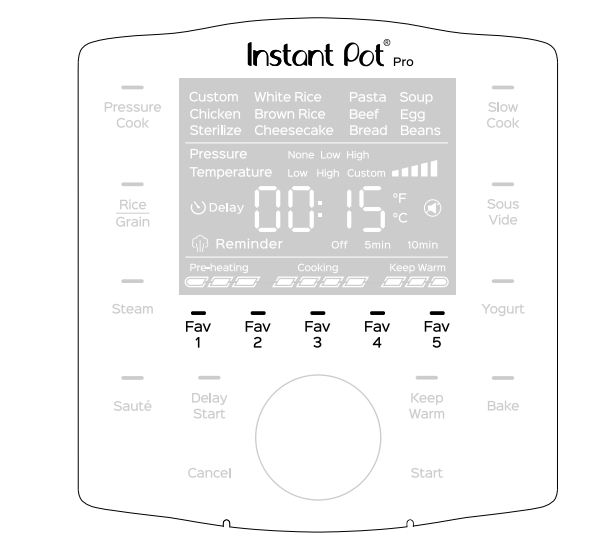
Saving recipes as Favorites
- Select any Smart program and set it up according to your recipe.
- When you’re happy with the settings, touch and hold any Fav key for 3 seconds to save the program.
That’s it! Your customized program is ready to use any time you want.
You can replace a saved Favorite with a new recipe by repeating these steps again.
Using Favorite recipes
Depending on your recipe, you can add your ingredients to the inner pot before or after Pre-heating.
- Touch the Fav key you want to use.
- Touch Start to begin. The display shows On and the progress bar shows Pre-heating. It’s really that easy!
- If you press a Fav key that hasn’t been saved as a Favorite, the display flashes [tbd] 3 times and returns to the previous screen.
Care, cleaning and storage
Clean your Instant Pot Pro and its parts after each use. Failure to follow these cleaning instructions may result in catastrophic failure, which may lead to property damage, severe personal injury.
Always unplug your multicooker and let it cool to room temperature before cleaning. Never use metal scouring pads, abrasive powders or harsh chemical detergents on any of the Instant Pot’s parts or accessories.
Let all surfaces dry thoroughly before use, and before storage.
| Parts | Cleaning methods and instruction |
|
Accessories
|
Dishwasher safe if placed on the top rack. |
|
Lid and parts
|
Dishwasher safe if placed on the top rack Remove all the parts from the lid before cleaning. See Care, cleaning and storage: Removing and installing parts.
|
| Inner pot |
Dishwasher safe.
|
| Power cord |
Wipe only.
|
| Multicooker base |
Wipe only.
|
Some discoloration may occur after machine washing, but this will not affect the multicooker’s safety or performance.
WARNING: The multicooker base contains electrical components. To avoid fire, electric leakage and/or personal injury, make sure the multicooker base always stays dry
- DO NOT immerse the multicooker base in water or other liquid or attempt to cycle it through the dishwasher.
- DO NOT rinse the heating element.
- DO NOT submerge or rinse the power cord or the plug.
Removing and installing parts
Silicone sealing ring
Remove the sealing ring
Grip the edge of the silicone and pull the sealing ring out from behind the circular stainless-steel sealing ring rack.
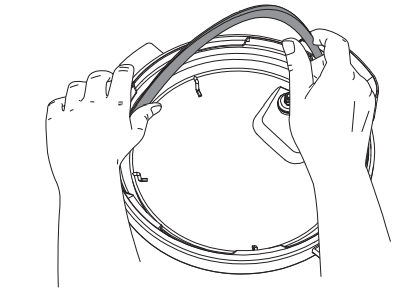
With the sealing ring removed, check the ring rack to make sure it is secured, centered, and an even height all the way around the lid. Do not attempt to repair a deformed ring rack.
 Instant Tip: The sealing ring is easiest to remove and install when it is wet and soapy.
Instant Tip: The sealing ring is easiest to remove and install when it is wet and soapy.
Install the sealing ring
Place the sealing ring over the sealing ring rack and firmly press it into place. Make sure there’s no puckering.
- It should be snug behind the sealing ring rack. It may wiggle a bit but shouldn’t fall out when you turn over the lid.
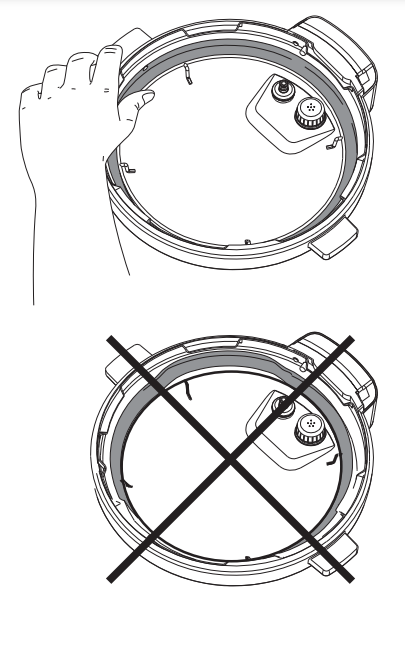
Steam release assembly
Remove the steam release assembly
Remove the steam release cover, then pull the steam release valve up and off the steam release pipe.
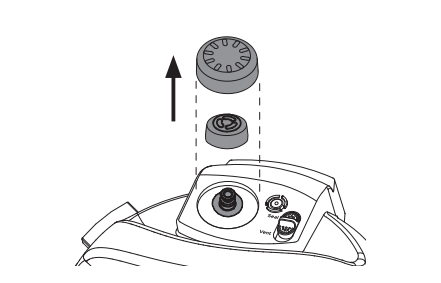
Install the steam release assembly
Place the steam release valve on the steam release pipe and press down firmly.
- The steam release valve sits loosely on the steam release pipe but should remain in place when the lid is turned over
Place the steam release cover over the steam release valve and press down. The cover pressure-fits in place.
QuickCool protective cover
Remove the protective cover
Grip the tab and push it towards the lid handle, then pull it up, towards you, and off.
Install the protective cover
Grip the tab and slide the cover towards the back of the metal portion of the lid, then press down until it clicks.
Anti-block shield
Remove the anti-block shield
Grip the lid like a steering wheel and use your thumbs to press firmly against the side of the anti-block shield (pressing towards the side of the lid and up) until it pops off the prongs underneath.
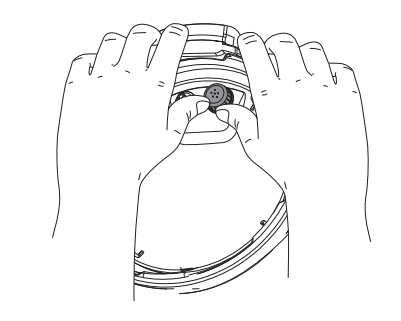
Install the anti-block shield
Place the anti-block shield over the prongs and press down until it snaps into position.
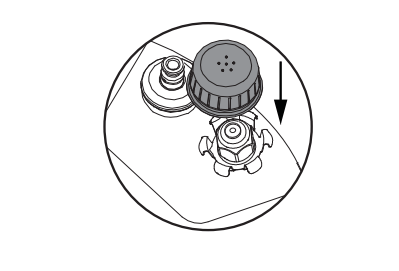
Float valve and silicone cap
Remove the float valve from the lid
Place one finger on the flat top of float valve, then turn the lid over. Detach the silicone cap from the bottom side of the float valve, and remove the float valve from the top of the lid.
- Do not discard the float valve or silicone cap!
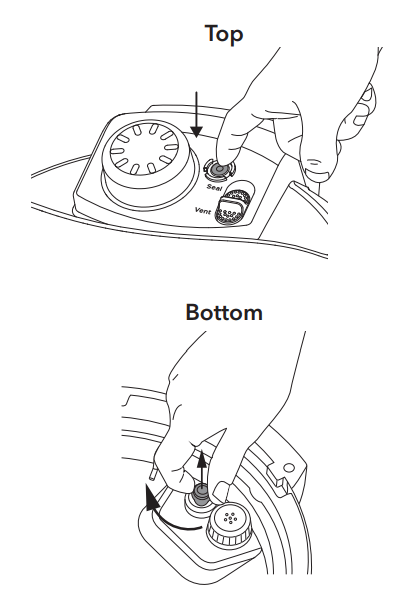
Install the float valve
Drop the narrow end of the float valve into the float valve hole on the top of the lid. Place one finger on the flat top of the float valve, then turn the lid over. Firmly attach the silicone cap to the bottom of the float valve.
Condensation collector
The condensation collector sits at the back of the multicooker base and catches any overflow from the condensation rim.
Remove the condensation collector
Pull the condensation collector away from the multicooker base; do not pull down. Note the tabs on the multicooker base and the grooves on the condensation collector.
Install the condensation collector
Align the grooves on the condensation collector over the tabs on the back of the multicooker base and slide the condensation collector into place like closing a drawer.
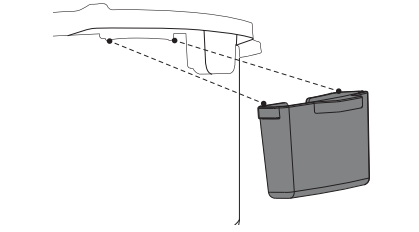
QuickCool protective cover
Remove the protective cover
Grip the tab and push it towards the lid handle, then pull it up, towards you, and off.
Install the protective cover
Grip the tab and slide the cover towards the back of the metal portion of the lid, then press down until it clicks.
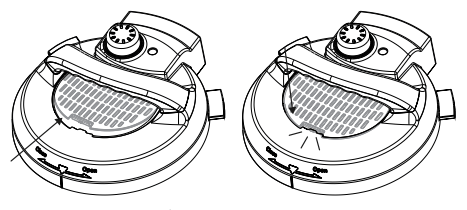
Troubleshooting
Register your Instant Pot today!
If your problem persists or if you have questions, get in touch with a Customer Care Advisor through our chat widget at instantpot.com/#chat, by email at [email protected] or by phone at 1-800-828-7280.
- Occasional clicking or light cracking sound.
- The sound of power switching and expanding pressure board when changing temperatures.
- This is normal; no action needed.
- Bottom of the inner pot is wet
- Wipe exterior surfaces of the inner pot. Make sure the heating element is dry before inserting the inner pot back into the multicooker base.
- The sound of power switching and expanding pressure board when changing temperatures.
- Difficulty closing the lid.
- Sealing ring is not properly installed.
- Reposition the sealing ring. Make sure it is snug behind the sealing ring rack.
- Float valve is in the popped-up position
- Gently press the float valve downward with a long utensil.
- Contents in multicooker are still hot
- Hold the quick release switch in the Vent position as you lower the lid onto the multicooker base slowly, allowing heat to dissipate.
- Sealing ring is not properly installed.
- Difficulty opening the lid.
- DANGER: Contents may be under pressure. To avoid scalding injury, DO NOT attempt to force the lid open.
- Pressure inside the multicooker.
- Release pressure according to recipe. Only open the lid after the float valve has dropped down.
- Float valve stuck in the popped-up position due to food debris or residue
- Release pressure completely, then tap the float valve gently with a long utensil. You may need to allow the multicooker to cool slightly so all pressure can be released.
- Open the lid cautiously, then thoroughly clean the float valve, surrounding area, and lid before next use.
- The inner pot is stuck to the lid when the multicooker is opened.
- Cooling of the inner pot may create suction, causing the inner pot to adhere to the lid.
- To release the vacuum, move the quick release switch to the Vent position.
- Cooling of the inner pot may create suction, causing the inner pot to adhere to the lid.
- Steam leaks from side of lid.
- No sealing ring in the lid
- Install a sealing ring.
- The sealing ring is damaged or not installed properly.
- Replace the sealing ring.
- Food debris attached to the sealing ring
- Remove the sealing ring and clean it thoroughly.
- The lid is not closed properly
- Open, then close the lid.
- The sealing ring rack is warped or off-center.
- Remove the sealing ring from the lid, then check the sealing ring rack for bends or warps. Contact Customer Care.
- The inner pot rim may be misshapen.
- Check for deformation and contact Customer Care.
- No sealing ring in the lid
- The float valve does not rise.
- Food debris on the float valve or float valve silicone cap.
- Remove the float valve from the lid and clean it thoroughly. Perform the Initial test run to check for function and record your findings. Contact Customer Care.
- Too little liquid in the inner pot.
- Check for scorching on the bottom of the inner pot. Add thin, water-based liquid to the inner pot according to its size. 6 Qt: 1 ½ cups (375 mL / ~12 oz) 8 Qt: 2 cups (500 mL / ~16 oz)
- Float valve's silicone cap is damaged or missing.
- Install or replace the float valve and/or silicone cap.
- Float valve obstructed by lid-locking mechanism.
- Tap the float valve with a long utensil. If the float valve does not drop, turn the multicooker off. Contact Customer Care.
- No heat in the inner pot.
- Perform the Initial test run to check for function and record your findings. Contact Customer Care.
- Inner pot base may be damaged.
- Perform the Initial test run to check for function and record your findings. Contact Customer Care.
- Food debris on the float valve or float valve silicone cap.
- Minor steam leaking or hissing from the steam release valve during the cook cycle.
- Quick release switch is not in the Seal position.
- Move the quick release switch to the Seal position. Add additional liquid to the inner pot.
- Multicooker is regulating excess pressure.
- This is normal; no action required.
- Too little liquid in the inner pot.
- Ensure there is minimum liquid in the inner pot
- Quick release switch is not in the Seal position.
- The display remains blank after connecting the power cord.
- Bad power connection or no power.
- Check outlet to make sure it is powered. Inspect power cord for damage. If damage is noticed, contact Customer Care.
- Multicooker’s electrical fuse has blown.
- Contact Customer Care.
- Bad power connection or no power.
- Steam gushes from the steam release valve when the quick release switch is in the Seal position.
- Not enough liquid in the inner pot.
- Add thin, water-based liquid to the inner pot according to its size. 6 Qt: 1 ½ cups (375 mL / ~12 oz) 8 Qt: 2 cups (500 mL / ~16 oz)
- Pressure sensor control failure.
- Contact Customer Care.
- Steam release valve is not seated properly
- Move the steam release switch to Vent then back to the Seal position.
- Not enough liquid in the inner pot.
- Error code appears on the display and the multicooker beeps continuously
- C1 C3 C4 C6
- Faulty sensor
- Contact Customer Care.
- Faulty sensor
- C7
- Heat element has failed.
- Contact Customer Care
- Not enough liquid. Pressure cooker lid is not used for pressure cooking functions.
- Add thin, water-based liquid to the inner pot according to its size. 6 Qt: 1 ½ cups (375 mL / ~12 oz) 8 Qt: 2 cups (500 mL / ~16 oz) Put on the lid and restart.
- Heat element has failed.
- C8
- Incorrect inner pot is used.
- Only use a stainless-steel Pro Series inner pot with easy grip handles with the Pro.
- Incorrect inner pot is used.
- Lid
- The lid is not in the correct position for the selected program.
- Open and close the lid.
- Do not use a lid when using Sauté.
- The lid is not in the correct position for the selected program.
- Food burn
- High temperature detected at bottom of inner pot; the multicooker automatically reduces the temperature to avoid overheating.
- Starch deposits at the bottom of the inner pot may have blocked heat dissipation. Turn the multicooker off, release pressure and inspect the bottom of the inner pot.
- High temperature detected at bottom of inner pot; the multicooker automatically reduces the temperature to avoid overheating.
- PrSE
- Pressure has accumulated during a non-pressure cooking program.
- Touch Cancel and Quick Release pressure.
- Pressure has accumulated during a non-pressure cooking program.
- C1 C3 C4 C6
Any other servicing must be performed by an authorized representative.
See other models: 140-5002-01 140-5001-01 140-5000-01 140-3012-01 140-3013-01
